牛津译林版八年级下册Unit 4 A good read Period 3 课件 (共26张PPT)
文档属性
| 名称 | 牛津译林版八年级下册Unit 4 A good read Period 3 课件 (共26张PPT) | 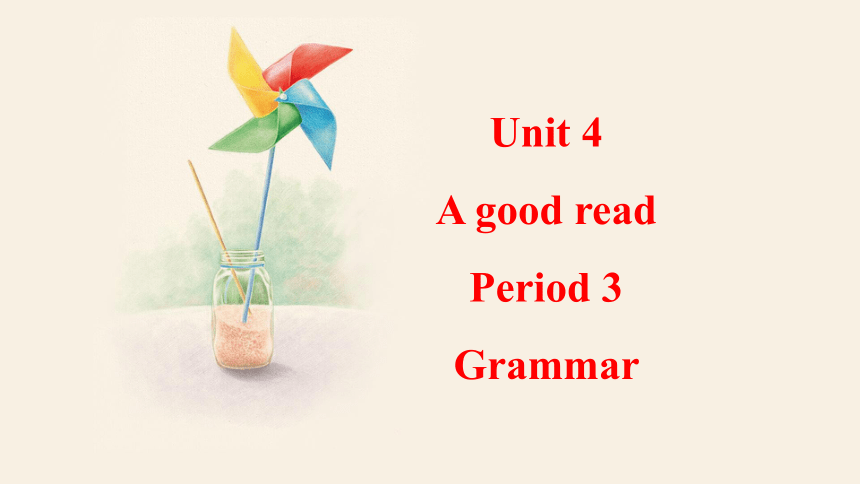 | |
| 格式 | pptx | ||
| 文件大小 | 1.6MB | ||
| 资源类型 | 教案 | ||
| 版本资源 | 牛津译林版 | ||
| 科目 | 英语 | ||
| 更新时间 | 2023-12-29 10:41:05 | ||
图片预览

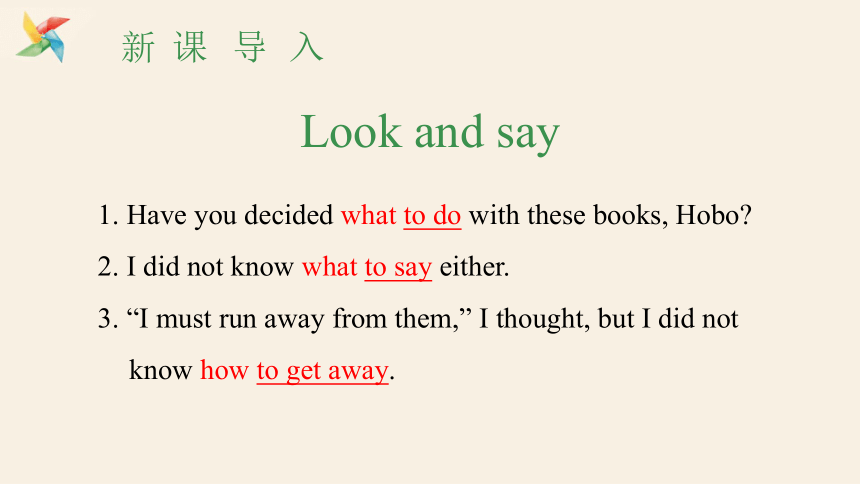
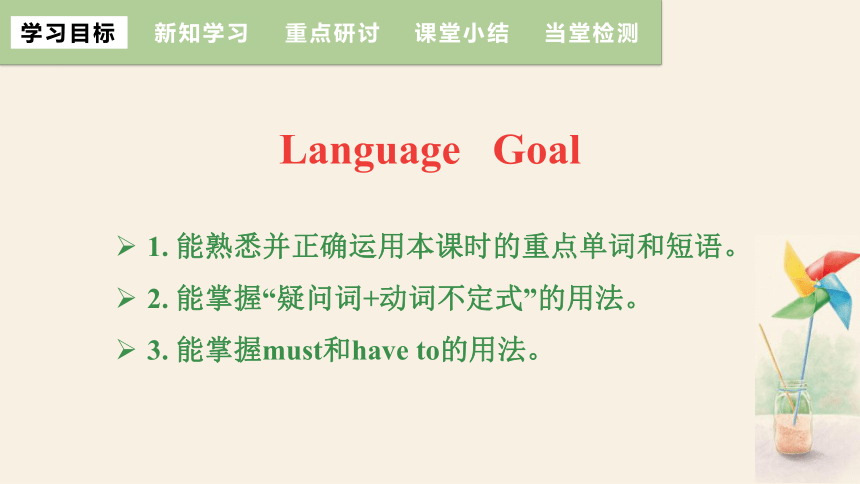
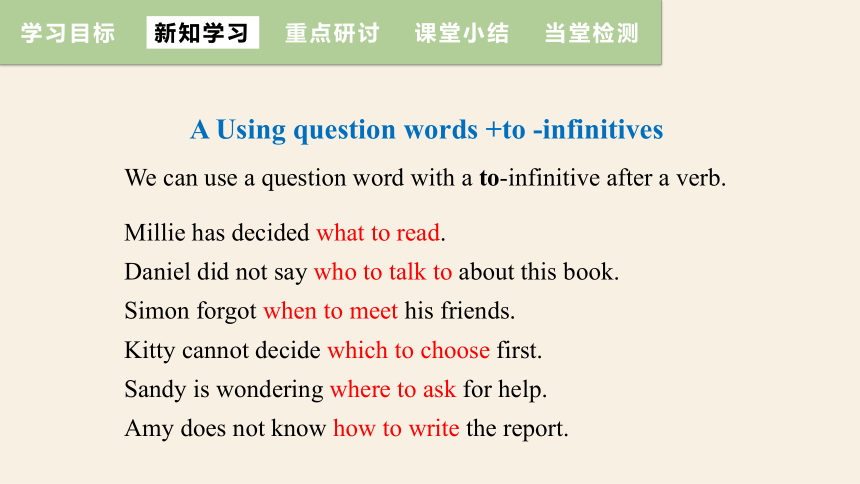

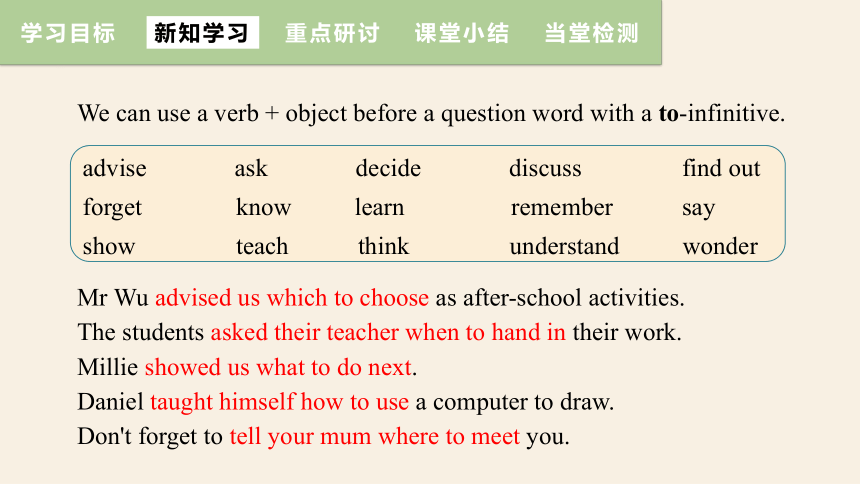

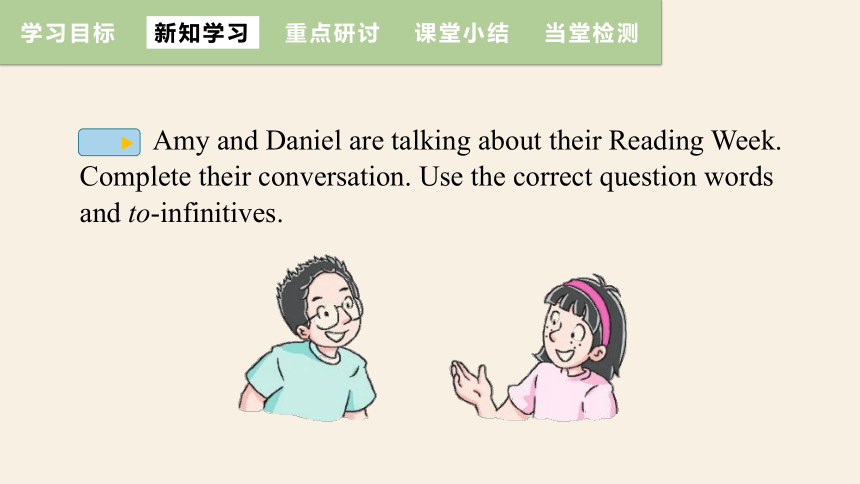

文档简介
(共26张PPT)
Unit 4
A good read
Period 3
Grammar
新
课
导
入
Look and say
12/28/2023
1. Have you decided what to do with these books, Hobo
2. I did not know what to say either.
3. “I must run away from them,” I thought, but I did not know how to get away.
Language Goal
1. 能熟悉并正确运用本课时的重点单词和短语。
2. 能掌握“疑问词+动词不定式”的用法。
3. 能掌握must和have to的用法。
新知学习
课堂小结
当堂检测
学习目标
重点研讨
新知学习
课堂小结
当堂检测
学习目标
重点研讨
A Using question words +to -infinitives
We can use a question word with a to-infinitive after a verb.
Millie has decided what to read.
Daniel did not say who to talk to about this book.
Simon forgot when to meet his friends.
Kitty cannot decide which to choose first.
Sandy is wondering where to ask for help.
Amy does not know how to write the report.
新知学习
课堂小结
当堂检测
学习目标
重点研讨
All question words can be used in this way, except why.
√
×
Suzy will explain why to recommend this book.
Suzy will explain why she recommend this book.
新知学习
课堂小结
当堂检测
学习目标
重点研讨
Mr Wu advised us which to choose as after-school activities.
The students asked their teacher when to hand in their work.
Millie showed us what to do next.
Daniel taught himself how to use a computer to draw.
Don't forget to tell your mum where to meet you.
We can use a verb + object before a question word with a to-infinitive.
advise ask decide discuss find out
forget know learn remember say show teach think understand wonder
新知学习
课堂小结
当堂检测
学习目标
重点研讨
Suzy was not sure who to ask for help.
Are you clear when to meet at the gate tomorrow
We can also use an adjective like sure or clear before a question word.
We can use a noun after what, which, whose, how many and how much.
They are discussing which color to paint the walls.
You can ask your parents how much money to take with you.
新知学习
课堂小结
当堂检测
学习目标
重点研讨
Amy and Daniel are talking about their Reading plete their conversation. Use the correct question words and to-infinitives.
▲
新知学习
课堂小结
当堂检测
学习目标
重点研讨
how what when
where which who
ask for find hand in
read travel write about
Amy: Mr Wu has recommended so many interesting books. Have you decided (1) ____________ first, Daniel
Daniel: Yes. I want to read Black Beauty first. But I don't know (2)
___________ the book.
Amy: You can try our school library or Sunshine Library. Oh, did you know Peter is reading Around the World in Eighty Days He wants to find out (3) ____________ around the world in such a short time.
which to read
where to find
how to travel
新知学习
课堂小结
当堂检测
学习目标
重点研讨
Daniel: Wow, that's amazing! By the way, can you tell me (4) ______________ our book report
Amy: Before next Friday. I'm still not sure (5) _________________ in the report.
Daniel: You can write anything about your book — what the book is about, what you think of it and so on. You should read some reviews about the book before writing.
Amy: Thank you. Anyway, I know (6) ______________ help with writing. Mr Wu is always there to help us.
when to hand in
what to write about
who to ask for
新知学习
课堂小结
当堂检测
学习目标
重点研讨
B Using must and have to
We use must and have to to say that it is necessary to do something.
We use must when the speaker feels that something is necessary.
“I must run away from them,” Gulliver thought.
We use have to when the situation makes something necessary.
I have to use them to reach the box on the fridge.
She has to take her daughter from school in the afternoon.
新知学习
课堂小结
当堂检测
学习目标
重点研讨
We use must not to say that something is not allowed.
You must not smoke in the library.
We use do not have to to say that it is not necessary to do something.
We do not have to go to school at weekends.
Tip:
Have to has different forms.
has to had to will have to have/has got to
Tip:
must not=mustn't do not have to=don't have to
新知学习
课堂小结
当堂检测
学习目标
重点研讨
Amy is telling her cousin Shirley some library plete what she says with must, must not, have to or do not have to.
▲
新知学习
课堂小结
当堂检测
学习目标
重点研讨
You (1) _____ keep quiet in the library.
You (2) _____ keep the books clean and tidy.
You (3) _______ draw or write on the books.
You (4) _______ eat or drink in the library.
You (5) _____ return the books on time. If you want to keep them longer, you (6) ______ renew them.
You (7) ____________ bring your student card every time you go to the library, but remember to bring your library card.
must
must
mustn't
mustn't
must
have to
don't have to
新知学习
课堂小结
当堂检测
学习目标
重点研讨
Language Points
1. The students asked their teacher when to hand in their work.
学生们问老师什么时候交作业。
hand in 上交,递交
e.g. Time's up. Stop writing and hand in your papers. 时间到了。不要再写了,把试卷交上来。
新知学习
课堂小结
当堂检测
学习目标
重点研讨
2. You can write anything about your book — what the book is about, what you think of it and so on. 你可以写任何关于你的书的东西——这本书是关于什么的,你对它的看法等等。
and so on ……等等
e.g. I like playing basketball, soccer ball, volleyball, ping-pong and so on. 我喜欢打篮球、足球、排球、乒乓球等。
新知学习
课堂小结
当堂检测
学习目标
重点研讨
3. You must return the books on time.
你必须按时归还书。
on time 准时,按时
e.g. She always pays her bills on time.
她总是按时支付账单。
新知学习
课堂小结
当堂检测
学习目标
重点研讨
疑问词+动词不定式
我们可以用“疑问词+动词不定式”结构作动词的宾语。疑问词包括疑问代词what、which、who和疑问副词how、when、where等。常和“疑问词+动词不定式”结构连用的动词及动词短语有:know、learn、see、hear、ask、tell、advise、decide、explain、find out、forget、remember、think、understand、wonder等。如:
I do not know what to say next. 我不知道接下来说什么。
I cannot decide which to take. 我不能决定该拿哪一个。
新知学习
课堂小结
当堂检测
学习目标
重点研讨
有些动词,如advise、ask、show、teach、tell等,其后可以接双宾语。如:
Please tell me how to get there. 请告诉我接下来说什么。
Sandy showed Millie how to start the online tour.
桑迪给米莉演示了如何开始这个在线旅游。
有些疑问词,如what、which、whose、how many、how much等,其后可以先接一个名词,再接动词不定式。如:
She wondered how many subjects to choose.
她不知道该选几门学科。
新知学习
课堂小结
当堂检测
学习目标
重点研讨
在“疑问词+动词不定式”结构前,有时也可以是如sure、clear等的形容词。如:
I am not sure which way to take.
我不确定走哪条路。
“疑问词+不定式”结构在句子中还可以作主语和表语。如:
How to deal with the problem is most important to us.
如何处理这个问题对我们来说最重要。
The problem is when to leave the place.
问题是何时离开这个地方。
新知学习
课堂小结
当堂检测
学习目标
重点研讨
“疑问词+不定式”结构可以改写成由该疑问词引导的从句。如:
I do not know what to do.
=I do not know what I should do.
注意:所有疑问词中,只有why不可以与动词不定式连用。
新知学习
课堂小结
当堂检测
学习目标
重点研讨
must/have to的用法
must表示主观的义务和必要,主要用于肯定句和疑问句,意思是“必须,得,要”。如:
You must finish your homework today. 你今天必须完成家庭作业。
must的否定形式must not表示禁止,意思是“不能,不许”。如:
You must not smoke here. 你不能在这里抽烟。
注意:must还可以表示肯定猜测,意思是“一定”。如:
You must be hungry after all that walking.
走了这么远的路,你一定饿了吧。
新知学习
课堂小结
当堂检测
学习目标
重点研讨
have to表示一种客观的需要,意思是“不得不”。have to有人称和数的变化。如:
It is getting dark. He has to go home now.
天快黑了。他现在得回家了。
Mum is out, so I have to look after the shop.
妈妈出去了,因此我不得不照看商店。
have to的否定形式是do not have to。如:
They do not have to buy a computer at the moment.
他们目前没有必要买电脑。
He does not have to go. 他不必走。
重点单词:
hand, review, return, renew, hand in, and so on, on time
“疑问词+动词不定式”的用法:
我们可以用“疑问词+动词不定式”结构做动词的_____,疑问词不包括____;该结构前除了动词还可以是___________和_______。
must/have to的用法:
must表示______的义务和必要,其否定形式是________;have to表示_______的需要,其否定形式是___________。
Unit 4
Period 3
新知学习
课堂小结
当堂检测
学习目标
重点研讨
宾语
why
动词+宾语
形容词
主观
must not
客观
do not have to
新知学习
课堂小结
当堂检测
学习目标
重点研讨
一、根据提示完成下列句子。
1. You must _______ (上交) in your projects by the end of this week.
2. Lucy hasn't finished reading the book, so she wants to _________ (续借) it.
3. Do you often read some ________ (评论) about the book before you start to write
4. He borrowed my iphone and hasn't _________ (归还) it to me.
5. Every day students should get to school and get home __________ (准时).
hand
renew
reviews
returned
on time
新知学习
课堂小结
当堂检测
学习目标
重点研讨
1. Have you decided ______ _____ ______ your holiday (怎样度过)
2. I don't know ______ _____ ______ at the meeting (说什么).
3. Can you tell me ______ ______ ______ this book (在哪里能买)
4. Drivers _______ (必须) wear seat belts while their cars are running on the road.
5. — _____ (必须) I finish my homework now
— No, ________________ (你没必要). Your work is over today.
how to spend
what to say
where to buy
Must
you don't have to
must
二、翻译下列句子。
Unit 4
A good read
Period 3
Grammar
新
课
导
入
Look and say
12/28/2023
1. Have you decided what to do with these books, Hobo
2. I did not know what to say either.
3. “I must run away from them,” I thought, but I did not know how to get away.
Language Goal
1. 能熟悉并正确运用本课时的重点单词和短语。
2. 能掌握“疑问词+动词不定式”的用法。
3. 能掌握must和have to的用法。
新知学习
课堂小结
当堂检测
学习目标
重点研讨
新知学习
课堂小结
当堂检测
学习目标
重点研讨
A Using question words +to -infinitives
We can use a question word with a to-infinitive after a verb.
Millie has decided what to read.
Daniel did not say who to talk to about this book.
Simon forgot when to meet his friends.
Kitty cannot decide which to choose first.
Sandy is wondering where to ask for help.
Amy does not know how to write the report.
新知学习
课堂小结
当堂检测
学习目标
重点研讨
All question words can be used in this way, except why.
√
×
Suzy will explain why to recommend this book.
Suzy will explain why she recommend this book.
新知学习
课堂小结
当堂检测
学习目标
重点研讨
Mr Wu advised us which to choose as after-school activities.
The students asked their teacher when to hand in their work.
Millie showed us what to do next.
Daniel taught himself how to use a computer to draw.
Don't forget to tell your mum where to meet you.
We can use a verb + object before a question word with a to-infinitive.
advise ask decide discuss find out
forget know learn remember say show teach think understand wonder
新知学习
课堂小结
当堂检测
学习目标
重点研讨
Suzy was not sure who to ask for help.
Are you clear when to meet at the gate tomorrow
We can also use an adjective like sure or clear before a question word.
We can use a noun after what, which, whose, how many and how much.
They are discussing which color to paint the walls.
You can ask your parents how much money to take with you.
新知学习
课堂小结
当堂检测
学习目标
重点研讨
Amy and Daniel are talking about their Reading plete their conversation. Use the correct question words and to-infinitives.
▲
新知学习
课堂小结
当堂检测
学习目标
重点研讨
how what when
where which who
ask for find hand in
read travel write about
Amy: Mr Wu has recommended so many interesting books. Have you decided (1) ____________ first, Daniel
Daniel: Yes. I want to read Black Beauty first. But I don't know (2)
___________ the book.
Amy: You can try our school library or Sunshine Library. Oh, did you know Peter is reading Around the World in Eighty Days He wants to find out (3) ____________ around the world in such a short time.
which to read
where to find
how to travel
新知学习
课堂小结
当堂检测
学习目标
重点研讨
Daniel: Wow, that's amazing! By the way, can you tell me (4) ______________ our book report
Amy: Before next Friday. I'm still not sure (5) _________________ in the report.
Daniel: You can write anything about your book — what the book is about, what you think of it and so on. You should read some reviews about the book before writing.
Amy: Thank you. Anyway, I know (6) ______________ help with writing. Mr Wu is always there to help us.
when to hand in
what to write about
who to ask for
新知学习
课堂小结
当堂检测
学习目标
重点研讨
B Using must and have to
We use must and have to to say that it is necessary to do something.
We use must when the speaker feels that something is necessary.
“I must run away from them,” Gulliver thought.
We use have to when the situation makes something necessary.
I have to use them to reach the box on the fridge.
She has to take her daughter from school in the afternoon.
新知学习
课堂小结
当堂检测
学习目标
重点研讨
We use must not to say that something is not allowed.
You must not smoke in the library.
We use do not have to to say that it is not necessary to do something.
We do not have to go to school at weekends.
Tip:
Have to has different forms.
has to had to will have to have/has got to
Tip:
must not=mustn't do not have to=don't have to
新知学习
课堂小结
当堂检测
学习目标
重点研讨
Amy is telling her cousin Shirley some library plete what she says with must, must not, have to or do not have to.
▲
新知学习
课堂小结
当堂检测
学习目标
重点研讨
You (1) _____ keep quiet in the library.
You (2) _____ keep the books clean and tidy.
You (3) _______ draw or write on the books.
You (4) _______ eat or drink in the library.
You (5) _____ return the books on time. If you want to keep them longer, you (6) ______ renew them.
You (7) ____________ bring your student card every time you go to the library, but remember to bring your library card.
must
must
mustn't
mustn't
must
have to
don't have to
新知学习
课堂小结
当堂检测
学习目标
重点研讨
Language Points
1. The students asked their teacher when to hand in their work.
学生们问老师什么时候交作业。
hand in 上交,递交
e.g. Time's up. Stop writing and hand in your papers. 时间到了。不要再写了,把试卷交上来。
新知学习
课堂小结
当堂检测
学习目标
重点研讨
2. You can write anything about your book — what the book is about, what you think of it and so on. 你可以写任何关于你的书的东西——这本书是关于什么的,你对它的看法等等。
and so on ……等等
e.g. I like playing basketball, soccer ball, volleyball, ping-pong and so on. 我喜欢打篮球、足球、排球、乒乓球等。
新知学习
课堂小结
当堂检测
学习目标
重点研讨
3. You must return the books on time.
你必须按时归还书。
on time 准时,按时
e.g. She always pays her bills on time.
她总是按时支付账单。
新知学习
课堂小结
当堂检测
学习目标
重点研讨
疑问词+动词不定式
我们可以用“疑问词+动词不定式”结构作动词的宾语。疑问词包括疑问代词what、which、who和疑问副词how、when、where等。常和“疑问词+动词不定式”结构连用的动词及动词短语有:know、learn、see、hear、ask、tell、advise、decide、explain、find out、forget、remember、think、understand、wonder等。如:
I do not know what to say next. 我不知道接下来说什么。
I cannot decide which to take. 我不能决定该拿哪一个。
新知学习
课堂小结
当堂检测
学习目标
重点研讨
有些动词,如advise、ask、show、teach、tell等,其后可以接双宾语。如:
Please tell me how to get there. 请告诉我接下来说什么。
Sandy showed Millie how to start the online tour.
桑迪给米莉演示了如何开始这个在线旅游。
有些疑问词,如what、which、whose、how many、how much等,其后可以先接一个名词,再接动词不定式。如:
She wondered how many subjects to choose.
她不知道该选几门学科。
新知学习
课堂小结
当堂检测
学习目标
重点研讨
在“疑问词+动词不定式”结构前,有时也可以是如sure、clear等的形容词。如:
I am not sure which way to take.
我不确定走哪条路。
“疑问词+不定式”结构在句子中还可以作主语和表语。如:
How to deal with the problem is most important to us.
如何处理这个问题对我们来说最重要。
The problem is when to leave the place.
问题是何时离开这个地方。
新知学习
课堂小结
当堂检测
学习目标
重点研讨
“疑问词+不定式”结构可以改写成由该疑问词引导的从句。如:
I do not know what to do.
=I do not know what I should do.
注意:所有疑问词中,只有why不可以与动词不定式连用。
新知学习
课堂小结
当堂检测
学习目标
重点研讨
must/have to的用法
must表示主观的义务和必要,主要用于肯定句和疑问句,意思是“必须,得,要”。如:
You must finish your homework today. 你今天必须完成家庭作业。
must的否定形式must not表示禁止,意思是“不能,不许”。如:
You must not smoke here. 你不能在这里抽烟。
注意:must还可以表示肯定猜测,意思是“一定”。如:
You must be hungry after all that walking.
走了这么远的路,你一定饿了吧。
新知学习
课堂小结
当堂检测
学习目标
重点研讨
have to表示一种客观的需要,意思是“不得不”。have to有人称和数的变化。如:
It is getting dark. He has to go home now.
天快黑了。他现在得回家了。
Mum is out, so I have to look after the shop.
妈妈出去了,因此我不得不照看商店。
have to的否定形式是do not have to。如:
They do not have to buy a computer at the moment.
他们目前没有必要买电脑。
He does not have to go. 他不必走。
重点单词:
hand, review, return, renew, hand in, and so on, on time
“疑问词+动词不定式”的用法:
我们可以用“疑问词+动词不定式”结构做动词的_____,疑问词不包括____;该结构前除了动词还可以是___________和_______。
must/have to的用法:
must表示______的义务和必要,其否定形式是________;have to表示_______的需要,其否定形式是___________。
Unit 4
Period 3
新知学习
课堂小结
当堂检测
学习目标
重点研讨
宾语
why
动词+宾语
形容词
主观
must not
客观
do not have to
新知学习
课堂小结
当堂检测
学习目标
重点研讨
一、根据提示完成下列句子。
1. You must _______ (上交) in your projects by the end of this week.
2. Lucy hasn't finished reading the book, so she wants to _________ (续借) it.
3. Do you often read some ________ (评论) about the book before you start to write
4. He borrowed my iphone and hasn't _________ (归还) it to me.
5. Every day students should get to school and get home __________ (准时).
hand
renew
reviews
returned
on time
新知学习
课堂小结
当堂检测
学习目标
重点研讨
1. Have you decided ______ _____ ______ your holiday (怎样度过)
2. I don't know ______ _____ ______ at the meeting (说什么).
3. Can you tell me ______ ______ ______ this book (在哪里能买)
4. Drivers _______ (必须) wear seat belts while their cars are running on the road.
5. — _____ (必须) I finish my homework now
— No, ________________ (你没必要). Your work is over today.
how to spend
what to say
where to buy
Must
you don't have to
must
二、翻译下列句子。
